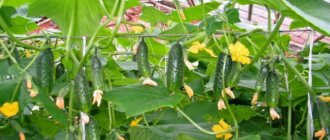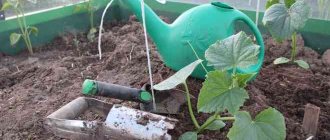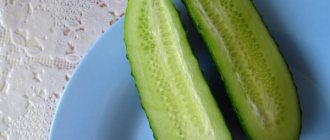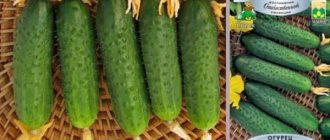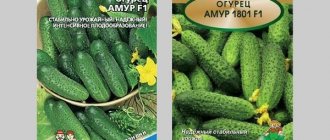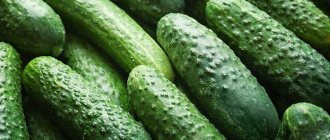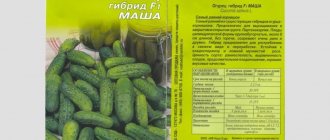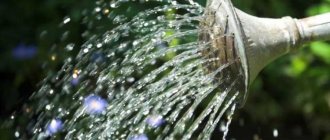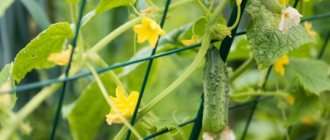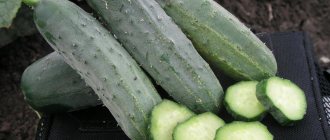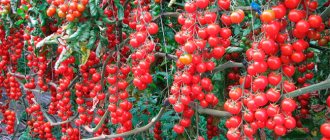In the description of the variety with photographs, the early ripening cucumber “Emelya F1” highlights such valuable characteristics as resistance to a complex of diseases, high productivity and tuberculation of smooth fruits. Due to its parthenocarpicity, the hybrid does not require the participation of bees during pollination and demonstrates stable yields in all weather conditions. Although “Emelya” has many positive reviews about the ease of cultivation and care, there is also a drawback inherent in all hybrids: it is impossible to use seeds collected independently for sowing next year.
"Emelya F1": biological description, history
The hybrid is the development of a breeding and seed production company, which is the originator of such famous cucumbers as “Amur F1”, “Ant F1”. “Emelya” became officially approved for cultivation in 2002, when all variety trials were successfully completed. The commission recommends cultivation in all regions, but not for large producers. The result of Russian selection is intended for cultivation in garden plots, homesteads and small farms in unprotected soil and under film cover.
Bushes
Cucumber is represented by indeterminate, powerful plants with strong growth. Strong lashes are covered with medium-sized leaf plates of light green color. The edges are slightly rounded and dissected. The veins are clear. When flowering, inflorescences collected in bunches of predominantly female type bloom. Pollinating insects are not required for successful ovary formation.
Fruit
The type of ovary formation is bouquet. The fruits are covered with a thin skin of a dark green color. Oval-cylindrical greens weigh on average about 130 g with a length of 13-15 cm and a diameter of 4 cm. The fruits have a characteristic tuberosity and white spines. The pulp is crispy, moderately juicy, and does not lose quality when overgrown. There is no bitterness even when cucumbers are poured under conditions of moisture deficiency.
The opinion of summer residents about the variety "Emelya"
Numerous reviews are mostly positive. Some summer residents strive to give practical advice to a novice gardener:
- Michael. Having once bought the Emelya variety of cucumbers, she has not stopped growing it to this day. The harvest is excellent, grown in a glass greenhouse. It is easy to care for, but the main thing is regular watering.
- Alexei. Due to the cold climate, cold-resistant varieties were sought. They advised me to buy Emelya. Grown in a greenhouse. Very tasty, not bitter.
Hybrid varieties of cucumbers are gradually replacing ordinary ones. Since the care is minimal, but there are more positive qualities. “Emelya” will delight summer residents not only with its unpretentiousness and harvest, but also with immunity to diseases.
Features and Specifications
On cucumber bushes, the fruits ripen early - on the 38-44th day from the moment of emergence. In areas where vegetables are grown by seedlings, the count begins with the rooting of seedlings in the beds. “Emelya” has immunity to cucumber mosaic virus, cladosporiosis, powdery mildew, and tolerance to peronosporosis. This is why the cucumber is valued in all cultivation regions, since the intensive development of fungal diseases leads to a significant crop shortage. Cucumber plantings tolerate sudden changes in daily temperatures without consequences.
For your information!
The fruits of the Emelya hybrid have high marketability, shelf life and excellent transportability. Thanks to this, in small farms in the southern regions, cucumber is cultivated for further sale in cooler areas.
Productivity, taste, purpose
The declared productivity of the hybrid for open ground is 12-16 kg/m². However, when cultivated under film, due to the longer fruiting period, the indicator increases by several kilograms from a similar area. However, in closed ground it is necessary to carefully monitor fertility. The cucumber is classified as a salad cucumber due to its thin peel, but it is also suitable for preservation, since the pulp is void-free and juicy. The taste is excellent.
Advantages and disadvantages
The hybrid has several disadvantages, which not all vegetable growers consider as such. The remaining characteristics of the cucumber are highlighted as advantages.
Table. Pros and cons of a hybrid
| Advantages | Flaws |
| Cold resistance | Lack of immunity to peronosporosis |
| Resistant to most specialized diseases | |
| High productivity, transportation and taste qualities | |
| Easy to care for | Inability to obtain seeds yourself |
| Friendliness and intensity of fruit formation | |
| Parthenocarpicity |
Diseases and pests
Since Emelya is a hybrid cucumber variety, it can resist some diseases, including cucumber mosaic and olive spot. But there are also diseases that sometimes have to be dealt with:
- Root rot. The main symptom of the disease is that the plant withers during the midday hours. To combat the disease, you need to use the following drugs: Ridomil, Fundazol, Topsin.
- Powdery mildew. It appears as whitish spots on the leaves and stem. The following drugs are used for the fight: Topaz, Cumulus, Tiovit Jet, Topsin.
Powdery mildew
As for pests, the most dangerous are:
- Aphid. You need to fight it with the help of the following drugs: Actelik, Inta-vir, Fitoverm.
- Spider mite. The following products are effective: Akarin, Aktelik, Inta-vir, Fitoverm.
- Whitefly. The following tools are used: Aktelik, Commander, Confidor.
Sowing cucumbers
Emelya cucumbers are grown in two ways: seedlings and non-seedlings. The second method is more suitable for cultivating pumpkin crops, since they have a delicate root system that does not tolerate picking. To make the seedlings take root faster, sow the seeds in peat pots. With the latter, the seedlings are planted in the beds. The optimal time for sowing seedlings is the end of April. Seeds or young bushes are sent to the beds in the prepared holes after night temperatures have established within 8 ° C, and daytime temperatures - 20. The soil at a depth of 10 cm should have time to warm up to 10-12 ° C.
Site selection and soil treatment
Vegetables prefer well-lit areas. The soil should be light, slightly acidic. The site is prepared in the fall by digging up the soil to a depth of 25 cm, adding additional humus or manure. Optimal predecessors: tomatoes, potatoes, onions, cabbage, peas. In spring, sand is added to areas with heavy soil to improve drainage qualities. Then the beds are harrowed, “closing” the moisture. Before this, if the soil is depleted, you can add ammonium nitrate at the rate of 15 g/m².
For your information!
Bad predecessors are pumpkin crops. The reason is a large supply of specialized harmful organisms.
Preparation of seed material
The seeds are used both dry and swollen. Prepare a solution based on water with the addition of boric acid at the rate of 20 ml of product per 1 liter. The seed material of the Emelya hybrid does not need to be disinfected, since it goes on sale after special treatment in the manufacturer’s factory. The procedure is known as panning.
Sowing technology
2 seeds are sown in peat pots. If cucumbers are grown in the traditional way, then perform the following steps for successful sowing:
- Prepare holes 2-4 cm deep with a distance of 30-40 cm.
- A handful of wood ash is placed into the recesses, then each is poured with boiling water (½ liter).
- Throw 2-3 seeds into the holes and sprinkle with soil.
How to grow cucumbers - video
Purchased seeds are planted in boxes or pots. The sowing depth of planting material is from 15 to 20 mm. Plantings are watered with warm water. The first shoots appear after about 5-6 days. They are fed with mineral fertilizers and watered with warm water once every 4 days. When the seedlings are 30 days old, they are transplanted to a permanent place.
Before planting young bushes on permanent soil, the beds are loosened. Apply organic fertilizers (manure, chicken droppings) to the soil. Along with them, wood ash is poured into the holes.
Plants are planted in such a way that the root neck does not go deep into the ground. If this condition is not met, the hybrid will die from root rot. It is recommended to immediately tie all bushes to the trellis. The format for planting bushes is 0.6 x 0.6 m. The planting density of the Emelya hybrid should not exceed 3 plants per 1 m² of sown area. Experts do not recommend removing stepchildren; in this plant they are relatively short in length, and ovaries develop on them, producing a lot of fruit.
Many vegetable growers choose the hybrid for its excellent yield, unpretentiousness and high taste of greens.
A lot of positive reviews from summer residents and gardeners indicate the great popularity of Emelya cucumbers (F1) due to the high commercial value of the fruit, as well as their universal use.
The agricultural technology of the Emelya F1 hybrid is not particularly different from the rules for growing other cucumbers and includes the following list of works:
- Sowing seeds. Seeds are planted one at a time in special containers to a depth of 2 cm. After a month, the seedlings can be planted in a permanent place.
Advice. The roots of cucumbers are very delicate and easily damaged. If transplanted incorrectly, the plant may die, so it is better to plant the seeds in peat cups, which will not need to be removed when planting the seedlings in the ground.
- Planting seedlings in prepared, organic-rich soil. The recommended planting density for the Emelya F1 variety is 3 plants per m². The root collar should not go deep into the ground - the plant may rot.
- Mandatory garter on trellises.
Cucumbers in a greenhouse
- Regular watering with warm water. Cucumbers are a moisture-loving crop, so soil moisture must be maintained at 60-80%, but no more.
- Application of fertilizers. In greenhouse conditions, it is recommended to feed plants 4-5 times per season. At the growth stage, cucumbers need nitrogen fertilizers, when flowers appear - in phosphorus fertilizers, and when they bear fruit, they must be fed with a complex of potassium and nitrogen fertilizers.
Gardeners who have already grown the Emelya F1 hybrid note, first of all, its ability to bear fruit well even with a prolonged drop in temperature. The yield and taste of this cucumber also received high marks. If desired, you can grow this variety even in city conditions on a glazed balcony.
Disadvantages include weak resistance to powdery mildew and the appearance of single, ugly-shaped fruits on the plant.
If you wish and spend a little time, you can get a good harvest of delicious Emelya F1 cucumbers in your own, even small greenhouse, regardless of the vagaries of the weather.
Emelya cucumbers can be sown in the ground or grown as seedlings.
Important! This vegetable loves light, non-acidic soil.
Seedling method
Since the root system of this vegetable crop is very delicate, it is recommended to plant the seeds for seedlings in separate containers. It would be better if these were peat pots that could be planted together with the plants in the ground, so as not to further injure the roots.
Peat substrate is best suited for planting seeds.
Rules for planting seedlings:
- Plant the seeds to a depth of 2 cm, the distance between the seeds should not be less than 8 cm.
- Moisten the soil with a spray bottle.
- Cover the containers with glass or polyethylene and place in a warm place (21...23°C).
- Be sure to ventilate every day and moisten as needed.
- In a couple of weeks the first shoots will appear.
Seedlings are planted in the ground at the age of 20–25 days, when 3–5 true leaves have formed. In a greenhouse there should be no more than 2–3 plants per 1 m²; if the soil is open, then 3–4 can be planted.
The area must be in a well-lit area. The soil needs to be prepared in the fall. To do this, dig up the ground to a depth of about 25 cm and add manure or humus. In the spring, you can also add additional fertilizers, but this time mineral fertilizers, not organic matter.
In the spring, before planting seeds, you can disinfect the soil with potassium permanganate (3 g per bucket of water). To disinfect greenhouses from pests, you can use sulfur smoke bombs or a bleach solution, which is used to treat all surfaces of the greenhouse. To reduce the acidity of the soil, add dolomite flour, slaked lime or chalk.
Planting material can be planted dry, or it can be pre-soaked in a damp cloth so that the seeds germinate. This will increase the germination percentage.
Holes are made in the ground at a distance of 0.3–0.4 m. A mixture of peat, humus, and mineral fertilizers is poured into the bottom of the holes and no more than 2–3 seeds are planted. The seeds are covered with earth so that they are at a depth of 1.5–2 cm, and warm water should be poured on top.
It should be said that this variety can be grown on the balcony. It is optimal for the windows to face east or southeast. In the south the rays may be too intense, then you will have to make shading shelters. Trimmed 5-liter plastic bottles or boxes of the appropriate size are well suited for planting. Instead of trellises, you can use stretched ropes. The rest of the care corresponds to growing in a greenhouse.
Cultivation care
The correct choice of site, as well as timely sowing, are not the only important measures when cultivating cucumbers. To ensure constant formation of even fruits on the vines, the bushes are systematically cared for. Since the Emelya hybrid has a bunch type of ovary formation, preference is given to the trellis method of cultivation, forming a bush at the initial stages.
Watering
Moisturize tree trunk circles regularly. The amount of moisture affects the intensity of crop yield. Water “Emelya F1” in the morning or evening using a watering can with a sprayer. The water is drawn warm so that low temperatures do not become an impetus for the development of fungal diseases. Before flowering, the consumption rate per 1 m² is 5-10 l, during the fruit production phase - twice as much. And during the formation of inflorescences, in order to increase the number of ovaries, watering should be limited.
Soil treatment
To maintain the looseness of the soil in tree trunk circles. The soil is processed weekly using a hoe to a depth of 2-3 cm. The procedures are carried out after watering or precipitation. To prevent vegetable crops from competing with weeds, the beds are kept clean. Weeding is carried out to a shallow depth so as not to injure the superficial root system of cucumbers.
Top dressing
"Emelya" responds well to fertility. For intensive growth and abundant fruiting, plants are fed systematically:
- At the beginning of the growth of vegetative mass, cucumber bushes are watered with a fertilizer solution, which is prepared from bird droppings and water in a ratio of 1: 20.
- During the formation of inflorescences, superphosphate is added.
- During fruiting, potassium sulfate is added to the phosphorus fertilizer, which is responsible for prolonging the phase.
For your information!
Liquid microfertilizers such as “Urozhay” and “Aquarin” demonstrate excellent results when combined with wood ash.
Bush formation
To obtain a rich harvest of the Emelya F1 cucumber, the vegetable crop is cultivated vertically. When the plants reach a height of 30 cm, they are tied up. Next, they begin to “blind” the first four nodes. removing both stepsons and ovaries. The main stem is pinched after it reaches the top of the trellis. The lateral processes are shortened so that 2-3 nodes with ovaries remain.
Protection from diseases and pests
The Emelya hybrid has excellent immunity to many diseases, but the plantings suffer from a number of pathogenic organisms: downy mildew, root rot. The development of the first disease is provoked by cool spring and summer with high humidity. And root rot, as a rule. – the result of a violation of the irrigation regime (systematic waterlogging). To prevent development, bushes are sprayed with biological products or fungicides (before flowering begins). Among the pests on the shoots, aphids and spider mites are noted to feed. The timely use of insecticidal preparations or less effective but safe folk remedies allows you to protect plantings.
Reviews about the hybrid
According to reviews from gardeners and summer residents, the Emelya F1 cucumber plant really has cold resistance, early ripening and high productivity, it is easy to grow, but you should not forget to install trellises to tie up the stem (see photo of the Emelya F1 cucumber below).
Many note that the growing method does not affect the taste of cucumbers in any way, and they are very suitable for pickling.
The only drawback is the defeat of powdery mildew and the presence of single fruits of an ugly appearance.
Conclusion: This crop variety has particularly valuable properties and can be grown both in open ground and on balconies. It is one of the 10 most productive varieties of cucumbers, so it is widely used among gardeners.
For more information about sautéing cucumbers, watch the video:
Harvesting and storage
You may be interested in: Favorable days for transplanting cucumbers in open ground Dates for planting cucumbers in May 2021 according to the lunar calendar The most favorable days for planting cucumbers in the Leningrad region according to the calendar of gardeners and gardeners
They begin harvesting the greens on the 38-44th day after the emergence of seedlings or the rooting of seedlings in the beds. The fruits of "Emelya" are removed from the vine every 2-3 days, which allows you to extend the fruiting period. The procedure is carried out by carefully unscrewing the saturated greens from the stalk, which is left on the bush. The right time is morning or evening. At this time, Zelentsy have the greatest elasticity.
The hybrid bears fruit in a friendly manner. The greens are harvested no earlier than the onset of technical ripeness, which is indicated by a length of 13-15 cm. The resulting harvest can be stored in the refrigerator or basement. The most suitable location must meet several requirements:
- temperature 5-8 °C;
- good ventilation;
- high humidity.
For your information!
Since cucumber is classified as a salad cucumber, it is not suitable for long-term storage.
Description of the variety
Emelya f1 is a product of the selection work of domestic seed biologists.
Included in the State Register of Russia in 2002 as a hybrid intended for cultivation in greenhouses and greenhouses. The bushes are indeterminate, vigorous, medium-branched, with a female type of flowering. The formation of ovaries is fascicular.
The culture is cold-resistant, with friendly fruiting. 7–10 fruits are formed in one leaf node.
In the photo - Emelya cucumbers.
The distinctive features of the hybrid are shown in the table.
Composition, calorie content and benefits
Nutritional value of cucumbers (per 100 g):
- calorie content - 14 kcal;
- proteins - 0.8 g;
- fats - 0.1 g;
- carbohydrates - 2.5 g;
- water - 95 g;
- fiber - 1 g.
Cucumbers are also rich in vitamins and minerals - see the table for more details.
Benefits for the body:
- lignans and cucurbitacins destroy cancer cells and reduce the risk of cancer;
- vitamin K maintains the strength of the skeletal system;
- potassium strengthens the cardiovascular system;
- fiber normalizes the functioning of the gastrointestinal tract;
- Vitamin C whitens freckles and age spots.
